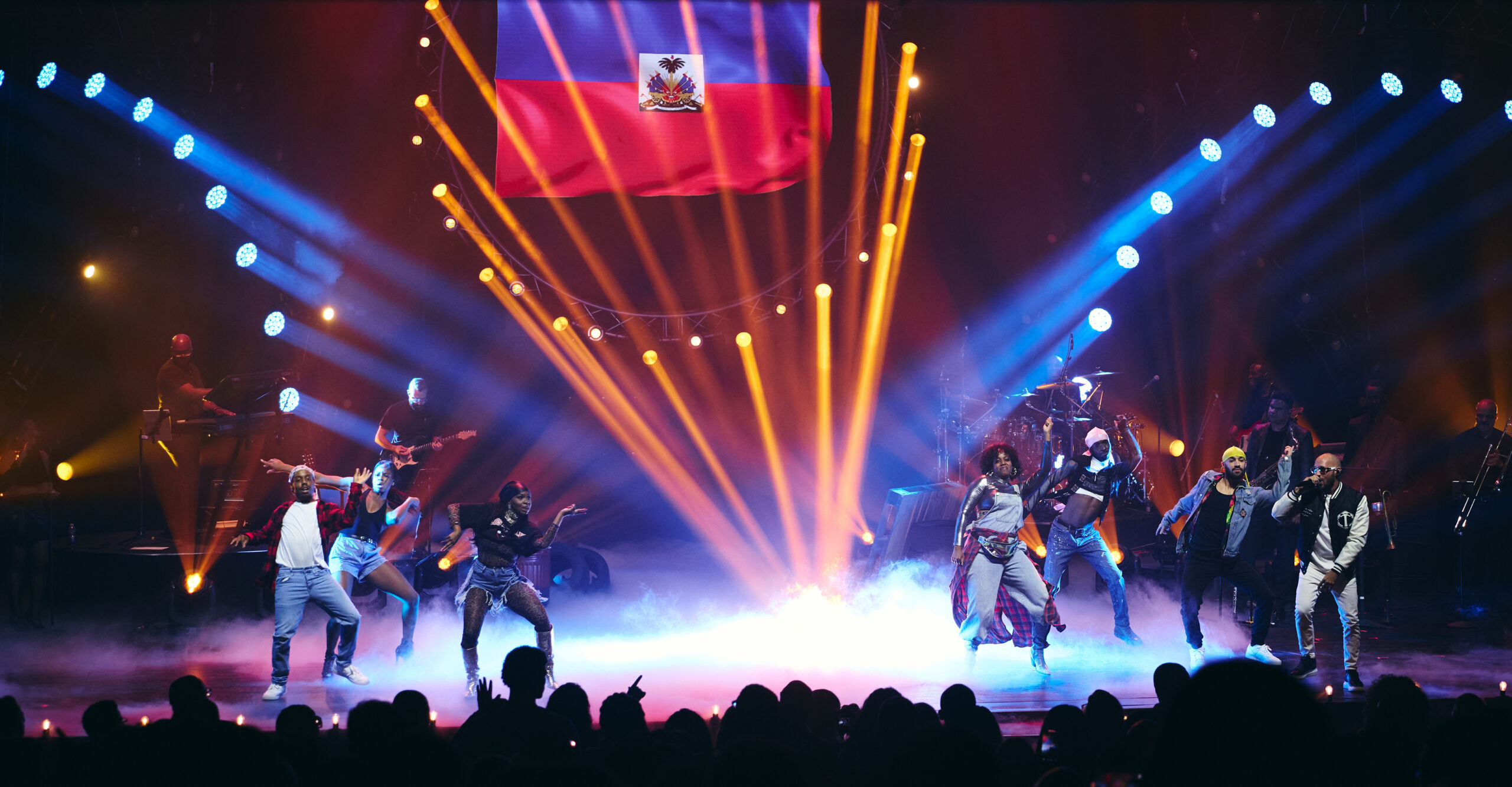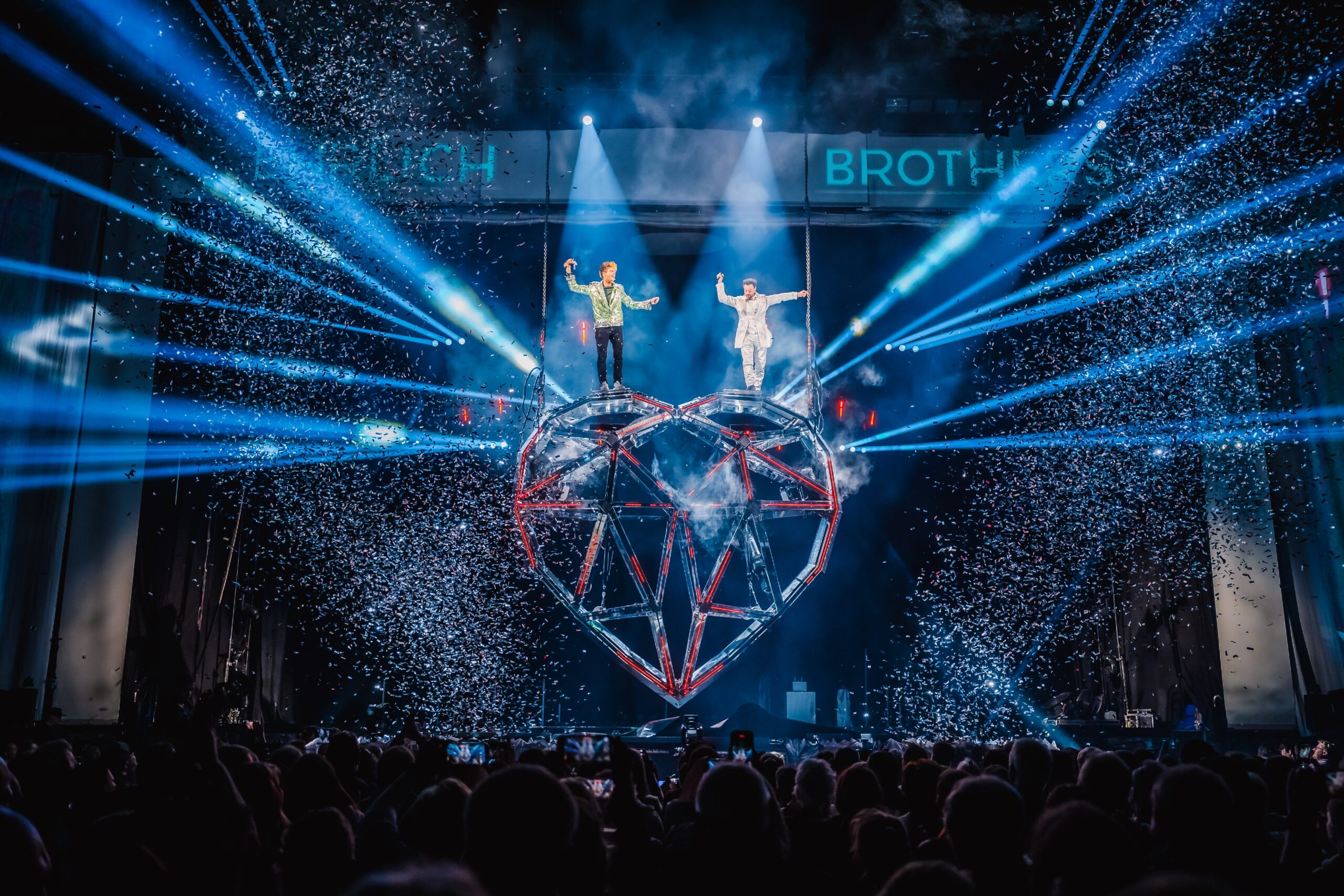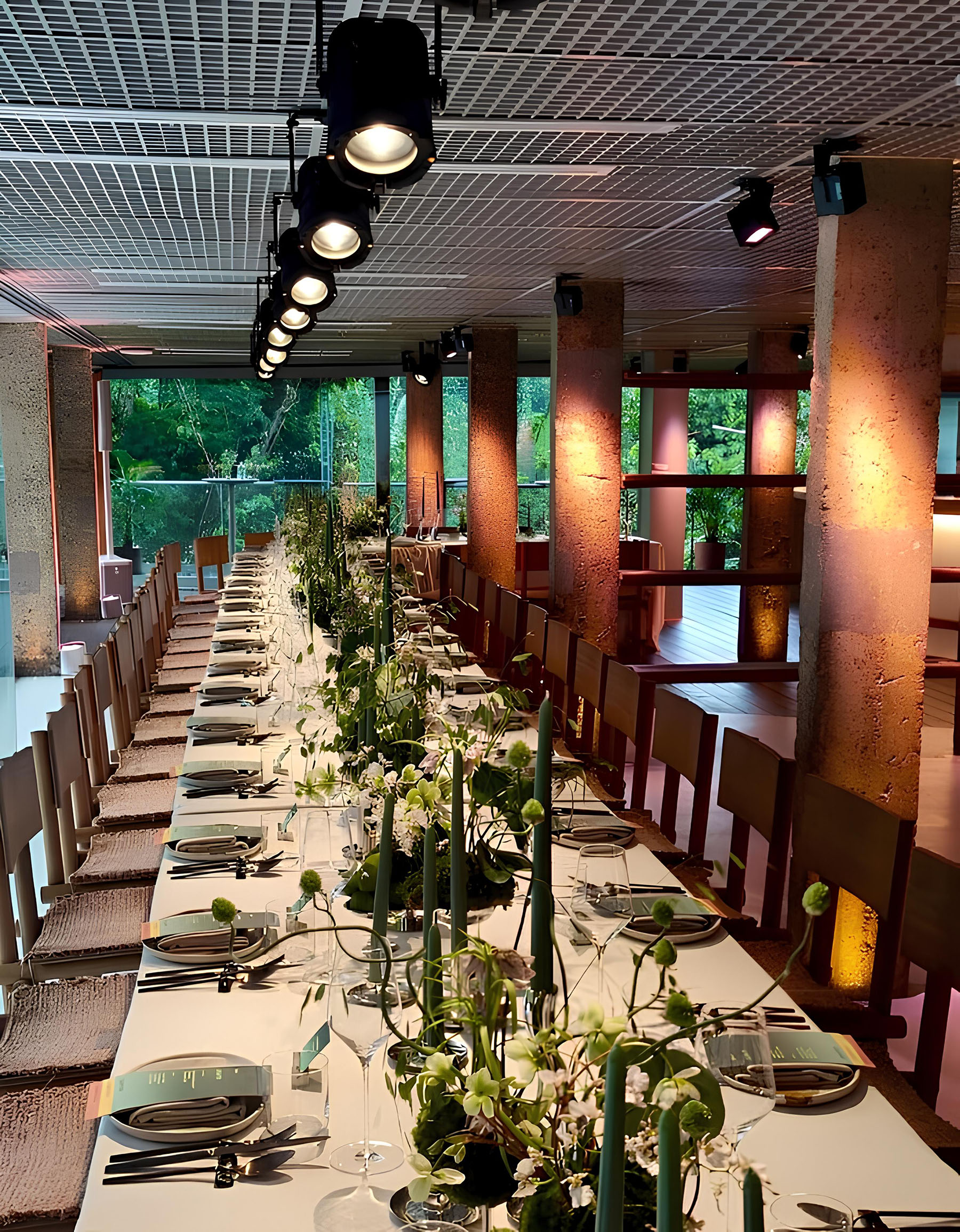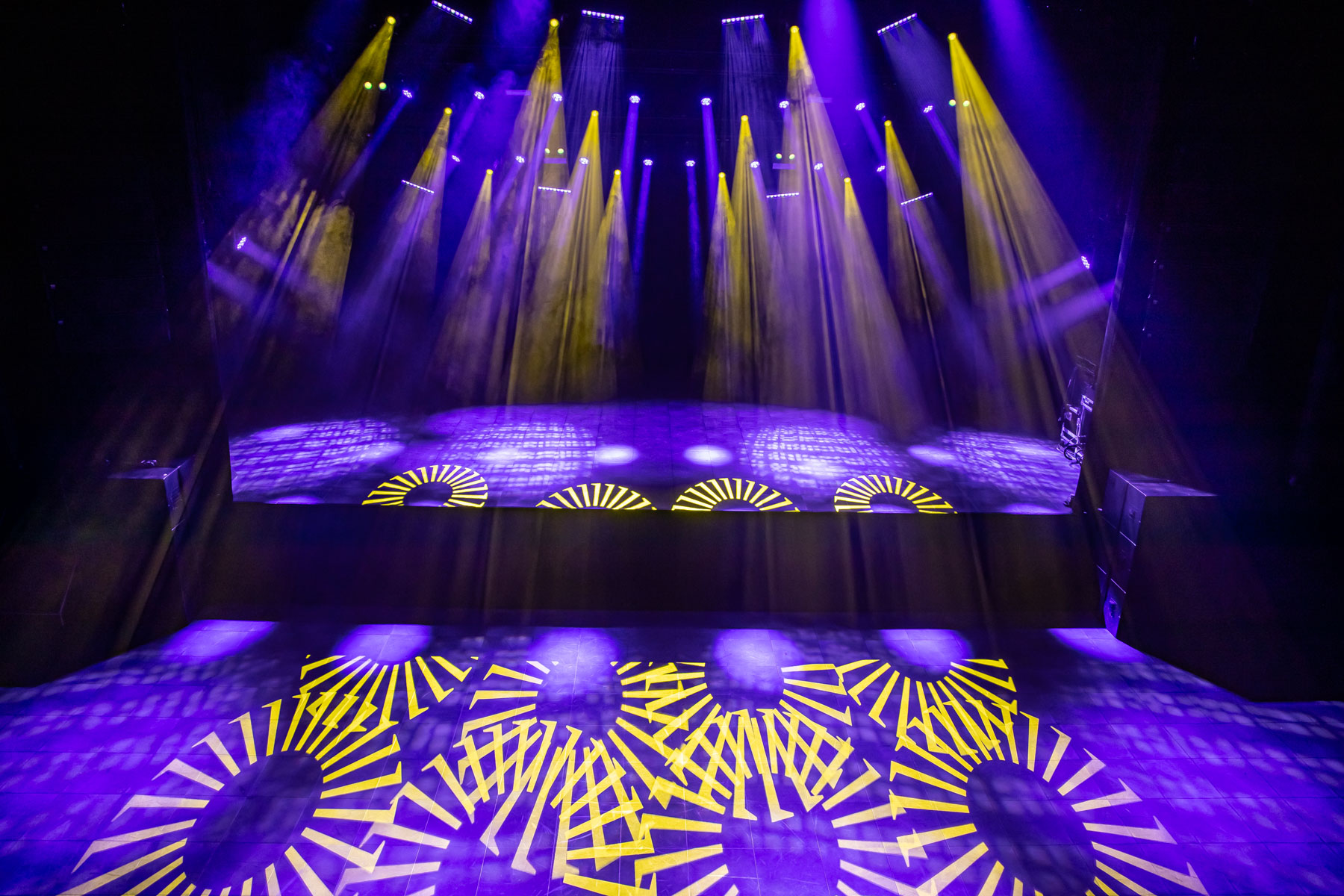More details from Gunther Hecker (http://www.gunther-hecker.de):
HEIDELBERG, Germany – Germany’s hip-hop band – Die Fantastischen Vier – AKA Fanta 4, just concluded their latest sold-out arena tour with set, lighting and visual design by Gunther Hecker.
The tour culminated in a homecoming performance at Stuttgart’s Hanns Martin Schleyer Halle.
Hecker worked in close collaboration with Marc Lorenz, who looked after all the LED screen and video elements, to create the show and specify the equipment. It has been acclaimed as one of the best stage presentations of Die Fantastischen Vier’s long and eventful career, which has put German hip-hop on the map.
Hecker has worked with the band since 1993 – and seen them undergo much evolution yet always staying at the forefront of the genre. He had always secretly longed to design an in-the-round show for them, thinking that the architecture and geometric form offered by geodesic circles and the 360 degree aesthetic would be perfect for their high-energy performance and enhance their already close interactive bonds with their audience.
The band always resisted until now. Heckler asked the band for 15 minutes in one of the early pre-tour meetings to convince them of his concept, and they went for it.
The 14 meter wide circular stage was built combining Lite Structures’ standard and custom products. It featured four five meter thrusts, each at 90 degree intervals around the stage.
Above, it was crowned by four circular trusses at 8, 10, 12 and 14 meter diameters, with the three smaller ones all on a 18 axis Cyberhoist system, operated by Ingo Koenzen, allowing them to move into a dynamic section of different positions.
Five hydraulic rams were integrated into the stage and used for entrances, one in the center and the other at the stage end of each of the thrusts. The show started with a lone sampler slowly elevating on one of these and the four Fanta 4 members mid stage, silhouetted by a hand-held photo-flood lamp against a circular cloth that kabuki’d in to reveal them.
The five piece backing band remained playing under the stage for the first three numbers and then made their entrance as the excitement and anticipation built, and the full show kicked in.
Below the Macrolon topped stage was 100 square meters of Martin Professional LC LED screen, which provided another trajectory of lighting and for those sitting higher up in the bleacher seating, an additional visual dimension.
The perimeters of all the above-stage trusses were clad with 1 meter high Pixled F-15 LED tiles amounting to 140 square meters.
The smallest – 8 meter – circle was also rigged with 16 Robe ColorSpot 2500E AT moving lights, 8 Martin Atomic strobes and 12 ETC PARs, the the only lights directly above the stage.
Four spine / finger trusses stretched out above the thrusts, each rigged with seven Robe ColorSpot 2500E ATs and seven ColorWash 2500E AT moving lights – chosen for their power and punch – plus two Atomics and nine square 4-lite Moles.
The lighting on these was ideally positioned for illuminating the runways and also blasting into the audience. A key part of the performance was to pull the audience into the action and ensure that they felt part of the show, so Hecker’s lighting and programming played an essential part in evoking this emotional response and connection between the band and their fans.
Circling the stage on the floor were 30 x JB Lighting A7 LED wash lights and four smoke machines were also on the floor for atmospherics.
Hecker operated the lighting using a Road Hog Full Boar console with a wing, complete with hot backup.
Video was completely integrated into the design from the outset, with Hecker and Lorenz also mindful to avoid all the current video and LED cliches.
The video screens were sometimes also used in a lighting role, with all the “regular” lights turned off and just the screens as the light source.
On the video control side of the show, they worked closely with Fantastichen Vier’s AndY (Andreas Rieke). He designed a custom control solution for the visual elements based on Apple’s Quartz Composer software system.
Live video/IMAG was used in about 70 percent of the show and the screens were active throughout. There were seven cameras for IMAG, three operated Sony DXC30Ps in the audience and three Panasonic Domecam remotes onstage, plus a Toshiba 1KHRIS full HD camera placed center-stage, and fitted with a 360 degree lens to produce special effects in two songs.
Franz Schlechter directed and mixed using a Panasonic AV-HS400A. He also designed and produced all the show playback content and ran both that and IMAG live.
The playback material was stored on one of four Mac Pro desktops – one running the Quartz Composer with two inputs – IMAG and playback footage – with both sources manipulated live using Modul8 real-time mixing VJ software running on another Mac Pro and Quartz Composer, which did most of the IMAG treatment.
This was all then fed into a Catalyst media server Mac Pro, used just for mapping the outputs to the different screen surfaces. The fourth Mac Pro was a backup.
Marc Lorenz set up the video control system. The video sequences and effects were mainly triggered via MIDI from AndY’s samplers, but once running, some were ‘played’ live in real time by Schlechter, challenging the Mac Pro’s NVIDIA Quadro 4000 graphics cards to crunch some serious numbers.
The set up enabled some organic mixing and matching between lighting and video effects, like in “Le Smou” where the hue of the video outputs was shifted to match Hecker’s lighting changes – in a beautiful fluid visual harmonization together with the rhythm and vibe of the music.
Says Hecker, “We created a special look that was a perfect fit for the band and their stage presentation and resulted in a great audience experience. After working for almost 20 years with them, it was great to see how they embraced the in-the-round, filling it with life, and integrating all the tech aspects so harmoniously with their on-stage behavior. Working so closly with AndY was really interesting. He made it possible to create some interesting looks and effects using the Quartz-Composer system that I had never seen or thought of before.”
Production Manager was Christof Matthiesen. Satis & Fy AG supplied the 11 trucks of equipment; Werne: all video, sound and lighting kit apart from the LED panels; XL Video Germany, Munich: Pixled LED screen; PRG Germany from Hamburg: Martin LC LED frames; and Gunther Hecker GmbH of Heidelberg: stage set and hydraulics.



